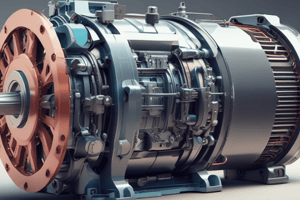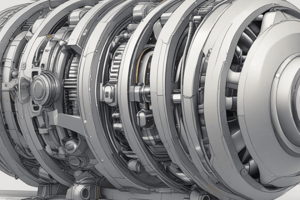Podcast
Questions and Answers
What is the purpose of making the stator flux rotating type in a single-phase induction motor?
What is the purpose of making the stator flux rotating type in a single-phase induction motor?
- To increase the motor's speed
- To make the motor self-starting (correct)
- To decrease the motor's torque
- To reduce the motor's efficiency
Why does a single-phase induction motor require some starting means?
Why does a single-phase induction motor require some starting means?
- Because the alternating flux cannot produce rotation in a stationary squirrel-cage rotor (correct)
- Because the motor is not self-sustaining
- Because the stator windings produce a rotating magnetic field
- Because the rotor is not laminated
What is the main problem with the pulsating flux produced by the main winding?
What is the main problem with the pulsating flux produced by the main winding?
- It is too weak
- It is alternating and does not rotate (correct)
- It is rotating in both directions
- It is too strong
What happens if the rotor of a single-phase I.M is rotated in one direction by some mechanical means?
What happens if the rotor of a single-phase I.M is rotated in one direction by some mechanical means?
What is the direction of rotation of the motor due to the forward rotating field?
What is the direction of rotation of the motor due to the forward rotating field?
What is the percentage of positive slip generated by the forward rotating field?
What is the percentage of positive slip generated by the forward rotating field?
What is the purpose of the aluminum bars in the squirrel cage rotor?
What is the purpose of the aluminum bars in the squirrel cage rotor?
What is the reason for a single-phase induction motor not being self-starting?
What is the reason for a single-phase induction motor not being self-starting?
What is the formula to calculate the slip (Sp) in a single-phase induction motor?
What is the formula to calculate the slip (Sp) in a single-phase induction motor?
What is the percentage of negative slip generated by the reverse rotating field?
What is the percentage of negative slip generated by the reverse rotating field?
What is the basis of the behavior of a single-phase induction motor?
What is the basis of the behavior of a single-phase induction motor?
What is the characteristic of a single-phase induction motor when connected to a single-phase a.c. supply?
What is the characteristic of a single-phase induction motor when connected to a single-phase a.c. supply?
What is the formula to calculate the negative slip (Sneg) in a single-phase induction motor?
What is the formula to calculate the negative slip (Sneg) in a single-phase induction motor?
What is the theory used to describe the operation of a single-phase induction motor?
What is the theory used to describe the operation of a single-phase induction motor?
What is the consequence of rotating the rotor of a single-phase I.M by some mechanical means?
What is the consequence of rotating the rotor of a single-phase I.M by some mechanical means?
Why is this method of starting not convenient for large motors?
Why is this method of starting not convenient for large motors?
What is the range of small positive slip that generates larger torque than a large negative slip?
What is the range of small positive slip that generates larger torque than a large negative slip?
What is the purpose of the auxiliary winding in a single-phase IM?
What is the purpose of the auxiliary winding in a single-phase IM?
What happens to the auxiliary winding when the rotor reaches synchronous speed?
What happens to the auxiliary winding when the rotor reaches synchronous speed?
According to the Double Revolving Field Theory, what is the magnitude of each rotating component?
According to the Double Revolving Field Theory, what is the magnitude of each rotating component?
What is the direction of rotation of the forward component of the stator flux?
What is the direction of rotation of the forward component of the stator flux?
What is the relationship between the synchronous speed and the supply frequency?
What is the relationship between the synchronous speed and the supply frequency?
What is the resultant of the two components Φf and Φb at start?
What is the resultant of the two components Φf and Φb at start?
Why are single-phase induction motors not self-starting according to double revolving field theory?
Why are single-phase induction motors not self-starting according to double revolving field theory?
What is the effect of the rotating field on the rotor, according to the Double Revolving Field Theory?
What is the effect of the rotating field on the rotor, according to the Double Revolving Field Theory?
What is the resultant of the two rotating components of the stator flux at any instant?
What is the resultant of the two rotating components of the stator flux at any instant?
What happens to the two components Φf and Φb after 90°?
What happens to the two components Φf and Φb after 90°?
What is the direction of the torque produced by the interaction of the rotor flux with the forward component Φf?
What is the direction of the torque produced by the interaction of the rotor flux with the forward component Φf?
What is the instantaneous value of the stator flux at θ = 90°?
What is the instantaneous value of the stator flux at θ = 90°?
What is the effect of the rotor flux interacting with the backward component Φb?
What is the effect of the rotor flux interacting with the backward component Φb?
What is the net torque experienced by the rotor at starting?
What is the net torque experienced by the rotor at starting?
What can be used to show the two oppositely directed torques and the resultant torque?
What can be used to show the two oppositely directed torques and the resultant torque?
According to the double-field revolving theory, how many constant-amplitude fluxes are produced in a single-phase induction motor?
According to the double-field revolving theory, how many constant-amplitude fluxes are produced in a single-phase induction motor?
What is the relationship between the equivalent circuits of the two motors in a single-phase induction motor?
What is the relationship between the equivalent circuits of the two motors in a single-phase induction motor?
What is the input power equation for a single-phase induction motor?
What is the input power equation for a single-phase induction motor?
What is the significance of the double-field revolving theory in understanding single-phase induction motors?
What is the significance of the double-field revolving theory in understanding single-phase induction motors?
What is the relationship between the rotor values in the equivalent circuit of a single-phase induction motor?
What is the relationship between the rotor values in the equivalent circuit of a single-phase induction motor?
What is the condition for a single-phase induction motor to operate in the running condition?
What is the condition for a single-phase induction motor to operate in the running condition?
What is the purpose of the capacitor in a single-phase induction motor?
What is the purpose of the capacitor in a single-phase induction motor?
What is an advantage of single-phase induction motors?
What is an advantage of single-phase induction motors?
Flashcards are hidden until you start studying
Study Notes
Single-Phase Induction Motor
- A single-phase induction motor is not self-starting, unlike a three-phase induction motor, and requires some starting means such as electric or electronic means.
- The single-phase stator windings produce a magnetic field that pulsates in strength in a sinusoidal manner, which does not rotate and therefore cannot produce rotation in a stationary squirrel-cage rotor.
Squirrel Cage Rotor
- The rotor has a laminated iron core with slots, and aluminum bars are molded on the slots and short-circuited at both ends with a ring.
- The rotor quickly accelerates until it reaches a speed slightly below the synchronous speed once it is rotated in one direction by some mechanical means.
Basics of Single-Phase Induction Motor
- A single-phase induction motor inherently does not develop any starting torque and therefore will not start to rotate if the stator winding is connected to a single-phase ac supply.
- However, if the rotor is started by auxiliary means, the motor will quickly attain the rated speed.
Double Revolving Field Theory
- The pulsating flux produced by the main winding can be resolved into two counter-rotating components (forward and backward components).
- The motor can be started in the direction of the forward rotating field, which generates a small (≈1-3%) positive slip.
- The reverse rotating field generates a larger (≈1.95%) negative slip.
- The interaction between the fields and the current induced in the rotor bars generates opposing torque.
Solution to Starting Torque Problem
- The single-phase induction motor can be made self-starting by adding an auxiliary winding in the slots of the stator to shift the EMF.
- The auxiliary winding and main winding are connected in parallel together and with the supply.
- When the rotor moves with speed until the synchronous speed, the auxiliary winding will open from the connection after a few seconds.
Torque/Speed Characteristics
- The two oppositely directed torques and the resultant torque can be shown effectively with the help of torque-speed characteristics.
Equivalent Circuit of Single-Phase Induction Motor
- A single-phase induction motor can be imagined to be consisting of two motors, having a common stator winding, but with their respective rotors revolving in opposite directions.
- Each rotor has resistance and reactance half the actual rotor values.
- The two equivalent circuits are connected in series.
- The current, power, and torque can be calculated from the combined equivalent circuit using network basics.
Review Questions
- What is a single-phase induction motor?
- How does a single-phase induction motor work?
- How do you test a single-phase motor?
- Which capacitor is used in a single-phase motor?
- What are the advantages of a single-phase induction motor?
- What are the applications of a single-phase induction motor?
Studying That Suits You
Use AI to generate personalized quizzes and flashcards to suit your learning preferences.





